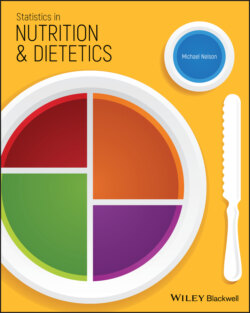Читать книгу Statistics in Nutrition and Dietetics - Michael Nelson - Страница 52
1.7.3 Significant Digits and Rounding
ОглавлениеIt always surprises me, when teaching undergraduate and postgraduate students, that they often don’t know how to round numbers properly. So when asked to present a result to two decimal places, for example, either they provide a string of numbers after the decimal place (far more than two) in the mistaken hope that somehow that is ‘better’ or ‘more accurate’, statistically speaking. Alternatively, it becomes evident that the concept of ‘rounding’ is not familiar to them, and their answers vary like leaves blowing in the wind.
The underlying principle is that when undertaking calculations, it is useful to retain as many digits as possible during the course of the calculation. This is what happens when you use your calculator, Excel, or SPSS [11]. This will produce the most mathematically precise result. However, when the final value is presented, it should contain no more significant digits than the numbers from which it is derived.
For example, calculate the average height of a group of five students, each of whom had been measured to the nearest centimetre (Table 1.1).
The average (the arithmetic mean) of these five values is 164.4 cm. However, presenting the result to the nearest millimetre (tenth of a centimetre) would be misleading, as it would imply that your starting observations had a similar level of precision. You should, instead, round the value for the result to the number of significant digits with which you started. In this case, round 164.4 cm (four significant digits) to 164 cm (three significant digits, to the nearest whole centimetre). This is the value that you should report for your result, as it reflects the level of precision of your original observations.12
TABLE 1.1 Height of Five Students (cm)
| 163 |
| 152 |
| 176 |
| 166 |
| 165 |
TABLE 1.2 Rules for Rounding
| Rule | Original Value | Rounded Value |
| If the final digit is less than 5, round to the value of the preceding digit | 164.4 | 164 |
| If the final digit is greater than 5, round to the value which is one higher than the preceding digit | 164.6 | 165 |
| If the final digit is equal to 5, and the preceding digit is odd, round up to the next even number | 163.5 | 164 |
| If the final digit is equal to 5, and the preceding digit is even, round down to the preceding number | 164.5 | 164 |
The standard conventions for rounding are as shown in Table 1.2.
These conventions may differ from those which you have been taught, but they are the conventions followed by all calculators and all computers when undertaking computations.
Some people have been taught always to round up if the last digit is equal to 5, but the calculations in Table 1.3 illustrate the error which is introduced if that rule is followed.
Although this error seems small, it can be substantial if we are dealing with small numbers. For example, if the original values had been 3.5, 4.5, 5.5, and 6.5, and we were rounding to whole numbers, the average would be equal to 5 for the original values and correctly rounded values (4, 4, 6, 6), but the average for the incorrectly rounded values would be 5.5 – an error of 10%!
Curiously, Excel and some statistical packages (e.g. Minitab) display numbers which are always rounded up when the last digit is 5. However, underlying calculations are based on the correct rules for rounding shown in Table 1.2. To ensure that your calculations are correct, always follow these rules.
Finally, be careful when reporting values from Excel or Minitab – even though the calculations will be right, the final displayed value may not accord with the rules above.
